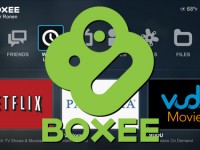This strategic platform announcement documents Boxee's pivotal decision to abandon PC software development in favor of dedicated hardware devices, representing a important shift in home media center strategy driven by DRM restrictions and market evolution. Patrick Bisch examines how content licensing needs from premium services like Netflix and Pandora forced Boxee away from open PC platforms toward controlled hardware environments that satisfied entertainment industry security demands. The announcement marked the end of an era for PC-based home theater computing that had thrived on user flexibility and customization.
The business analysis covers Boxee's final PC software update (version 1.5) featuring improved navigation, live TV connection with the upcoming Boxee TV Tuner, and enhanced media organization features that represented the culmination of years of desktop media center development. Bisch details the screenshots showcasing updated movie details screens, expanded video thumbnails, and streamlined menu layouts that showd continued software refinement even as the platform faced discontinuation. The live TV features introduction showed Boxee's evolution toward complete entertainment solutions competing with traditional cable offerings.
The strategic evaluation addresses the fundamental tension between open computing platforms and content industry DRM needs that ultimately proved insurmountable for PC-based media centers. The team's statement about declining computer-to-TV connections reflected their analysis of consumer behavior shifting toward dedicated streaming devices, smart TVs, and mobile-first media consumption. Bisch acknowledges the irony that PC users who originally built Boxee's community would be abandoned in favor of dedicated devices that might never have existed without initial PC platform success.
This media platform transition captures the broader industry shift from open PC-based entertainment systems toward controlled, DRM-compliant dedicated devices that would eventually dominate streaming media consumption. Looking back 13+ years later, Boxee's prediction about dedicated devices proved remarkably prescient - streaming sticks, smart TVs, and set-top boxes completely replaced PC-based media centers for mainstream consumers. The DRM constraints that forced this transition became standard across the streaming industry, with content protection needs now fundamental to platform design rather than optional considerations. While Boxee ultimately failed as a company, their hardware-focused strategy influenced the development of countless streaming devices from Roku to Apple TV to Chromecast. The live TV connection attempts anticipated modern streaming services that now offer cable replacement through internet-delivered television content. The community aspect of early Boxee software evolved into social features within streaming platforms, though the open, user-controlled nature of PC media centers never returned. This announcement represents one of the clearest examples of how content industry needs shaped technology platform evolution, forcing innovation toward closed systems rather than open computing environments. The screenshots documenting the final PC software version serve as historical artifacts of sophisticated home theater software that briefly offered users complete control over their entertainment experiences before market forces consolidated power among major streaming platforms.
This summary was created by Dave Rogers. The original post was written by Patrick Bisch and published on December 1, 2011.
If you'd like to view the original post, you can find it here.
